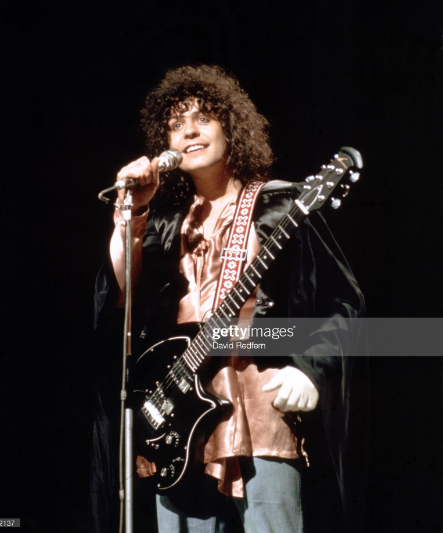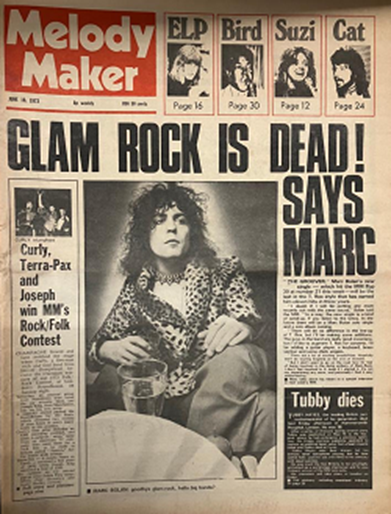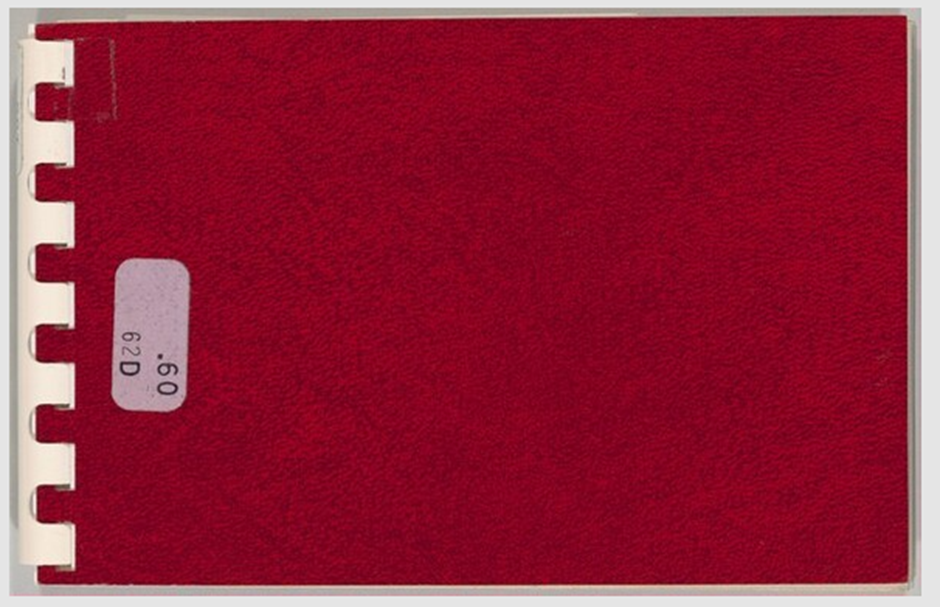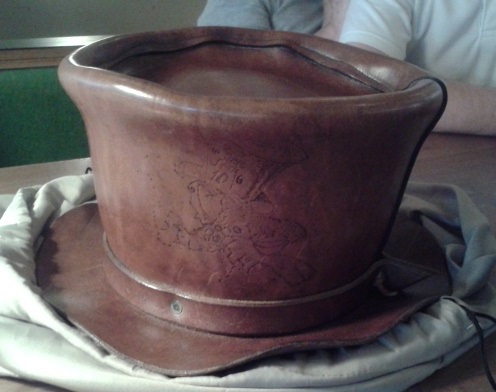As part of its Missing Believed Wiped series, expertly curated by Dick Fiddy, on 3 December 2022 the BFI Southbank screened a selection of previously lost Top of the Pops performances. Recorded onto Super 8 from a 12” colour television by former club DJ Roger Hill, the clips from April to August 1973 featured many acts which had found great success during the UK Glam Rock boom: Roxy Music, Suzi Quatro, Slade, Sweet, Mud and Mott The Hoople. Top of the bill for many was the first sight in over 49 years of T.Rex performing their single The Groover – a performance which permanently punctured the Glam Rock balloon.
It was on Top of the Pops that Marc Bolan launched the genre and it was on the same programme that he took his leave from the Glam scene. Both occasions led to profound changes in his life.
The first performance of Hot Love was recorded on 10 March 1971, broadcast the following day and introduced by Ed ‘Stewpot’ Stewart. T.Rex as they appeared here were still in their half-grown form: Marc Bolan on guitar and vocals, the recently-recruited moustachioed Steve Currie on bass, with Mickey Finn rather unconvincingly miming the drums: regular drummer Bill Legend had yet to be publicly unveiled.
T.Rex shared the show with Deep Purple, Chairmen of the Board, Nana Mouskouri and Mungo Jerry. Bolan stood out: his corkscrew crown of curls, a silver Alkasura sailor top with matching trousers and Anello and Davide character shoes setting him apart, demanding attention. Singing a live vocal over a backing track, he was yet to perfect all his trademark pouts and punches, fluffing a couple of lines along the way, but with the single having risen rapidly to number 7 in the charts, he knew that his time had come. Within a week, Hot Love was the best-selling UK single and T.Rex had made it.
On 24 March T.Rex were back in the BBC studios to record another performance. Hot Love was number one for a second week (of six) and Bolan celebrated in a black/green version of the Alkasura sailor top, yellow satin trousers and, most importantly, a dab of glitter under each eye. His stylist Chelita Secunda had taken him to meet John Lloyd at Alkasura (304 King’s Road) and then to Zandra Rhodes. It was Chelita’s addition of glitter to Bolan’s face that helped to send T.Rex stratospheric: they became an unstoppable cultural force. The music and the style were perfectly matched, with Bolan the innovator whose dash and daring opened the door for everything which followed.
Fast forward to the early summer of 1973. T.Rex had scored four UK number one hit singles, three chart-topping albums and millions of record sales around the world but were tired from a seemingly endless touring schedule; Bolan knew it was time for change.
On 1 May 1973 T.Rex performed live at the Santa Monica Civic Auditorium, delivering exuberant versions of Jeepster, Buick Mackane and forthcoming single The Groover for ABC TV’s In Concert show. What is immediately apparent is that the change had begun: the four piece band is augmented by Gloria Jones and Stephanie Spruill on additional vocals. On The Groover the two women are far more than backing singers, bringing a new dimension to T.Rex as a live attraction. It is also noticeable that Gloria and Marc are wearing matching black and white striped shirts: a sign of further changes ahead.
Back in London the following week, T.Rex recorded new tracks including Blackjack and Squint Eye Mangle, released by EMI on 10 August under the Big Carrot moniker. The lead vocals were by Gloria and Stephanie. In essence these songs were a try out for the sound Bolan was developing for the next T.Rex album, A Creamed Cage In August/Zinc Alloy and the Hidden Riders of Tomorrow – but slipped out semi-anonymously to test the waters.
Which brings us to 30 May 1973. T.Rex returned to the BBC at White City to perform The Groover, due for release as a single two days later but, given T.Rex’s status, screened on the programme on the day it hit the shops. By this time Bolan, aged 25, was a veteran. It was the 19th time T.Rex had performed on the UK’s flagship music show. Including repeats and Pan’s People interpretations, their hits had been featured over 40 times.
Introduced by Kenny Everett, T.Rex were sandwiched between Suzi Quatro and Elvis Presley, with Stealers Wheel, the New Seekers and Wizzard also performing.
On a small stage with one camera stage left, another behind the tightly pressed audience, the four-piece made the most of their allotted three minutes: Bill Legend in mirrored shades, Mickey Finn sporting a trilby, and Marc with his black Ovation Breadwinner guitar, a salmon colour Alkasura blouse/shirt and red trousers.
A closer look reveals that Marc is also wearing a black cape with a white glove on his left hand, while Mickey wears one on his right.
As Marc sings about himself, Glam’s most glamorous couple are telling us something: undertaker and pallbearer are here to deliver Glam Rock its last rites.
In case that was too subtle, on 7 June Marc was interviewed at Newton’s Restaurant on the King’s Road, Chelsea, by long-time supporter Chris Welch of Melody Maker. For the issue dated 16 June the banner headline told the world what Bolan had been hinting at:
GLAM ROCK IS DEAD! SAYS MARC.
“I doubt I will be putting any more records out with the same sound. In a way, the new single is a kind of send-up, if you listen to the lyrics.”
He went on to add, “the guys in the band are really good musicians but I’d like to augment T.Rex for concerts. I’ll be adding a guitar player, a keyboard, brass section and some chick singers. There are a lot of exciting possibilities.”
And then, the killer pay-off: “I don’t want to go on the road now for fear of being involved in the dying embers of Glam-Rock. I don’t feel involved in it, even if I started it. It’s not my department any more and personally I find it very embarrassing.”
As ever, Bolan started a trend: on 2 July 1973 Brian Eno left Roxy Music. The following evening David Bowie killed off Ziggy Stardust and the Spiders from Mars at their final concert at the Hammersmith Odeon.
Glam wriggled and writhed, stomped and shouted a little longer but they all knew that the game was up and it was time to move on
Bolan wasted no time in delivering on his promise. By 17 June he was installed in Musicland studios in Munich with T.Rex augmented by Jack Green on second guitar, and Gloria Jones joined by ‘Sister’ Pat Hall on vocals – while Bolan’s wife June was notably absent from the trip. During a week-long residency the band recorded up to 20 tracks. Marc described the new sound as, “Space age funk – Interstellar SuperSoul”.
The professional relationship between Marc and Gloria grew personal in the final days of July 1973. Within a fortnight his three year marriage to June was over.
The Groover was the final outing for T.Rex (Mark I) on Top of the Pops. In February 1974 Bolan gave a solo performance in support of the single (Whatever Happened To The) Teenage Dream, but it was not until July 1975 that a very different T.Rex returned to the BBC to perform their summer hit New York City, with Gloria Jones playing clavinet and only Steve Currie remaining from the classic line-up. The two years between The Groover and New York City was a lifetime in this context, during which the embers of Glam were continually raked over by the pantomime-end of the genre but Marc Bolan was happily out of sight.
————————————————————————————————————————————————————
With thanks to Paul Johnstone and Cliff McLenehan, whose indispensable book Marc Bolan: A Chronology is now available in an updated Kindle edition.
Text is © Martin Barden January 2023





